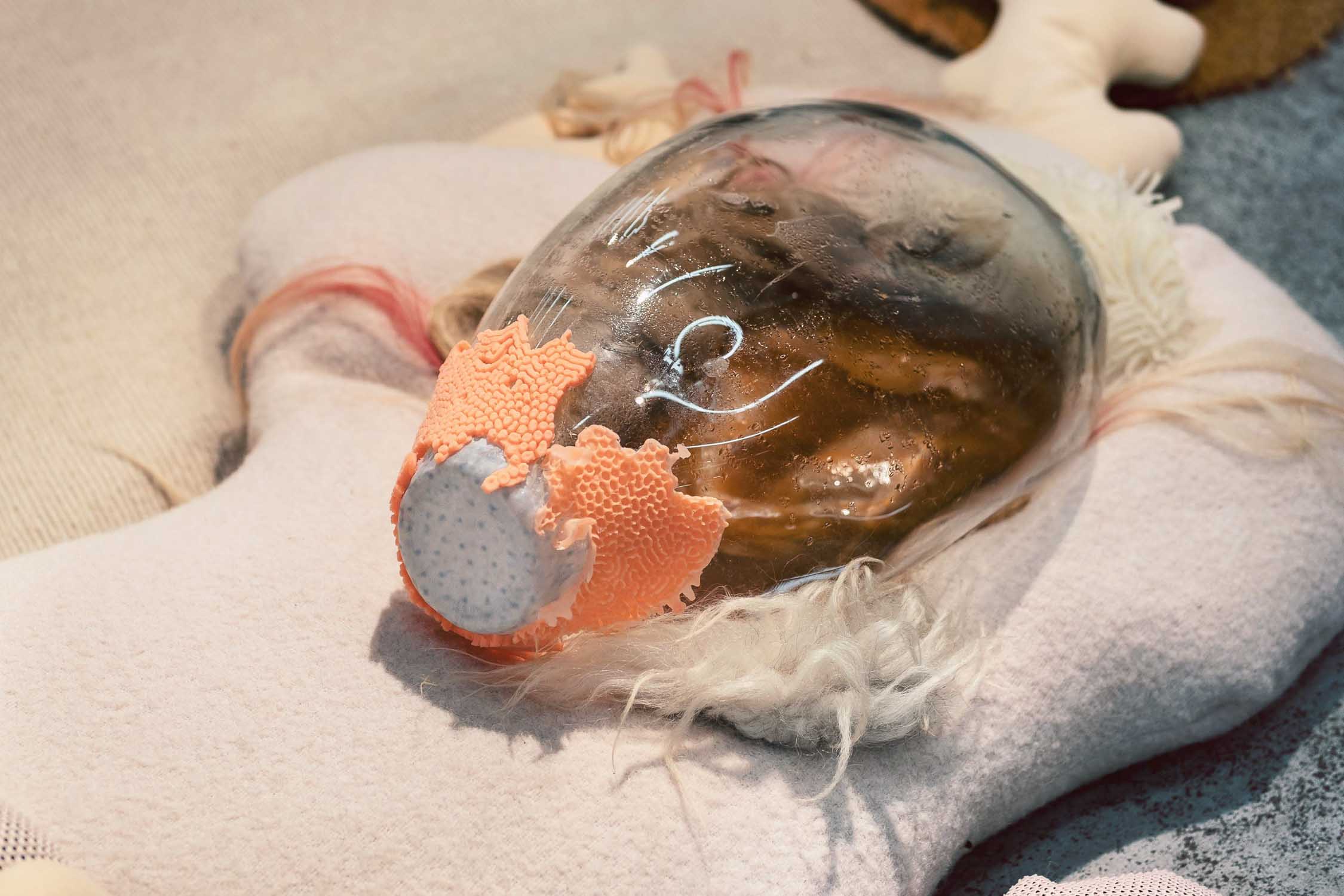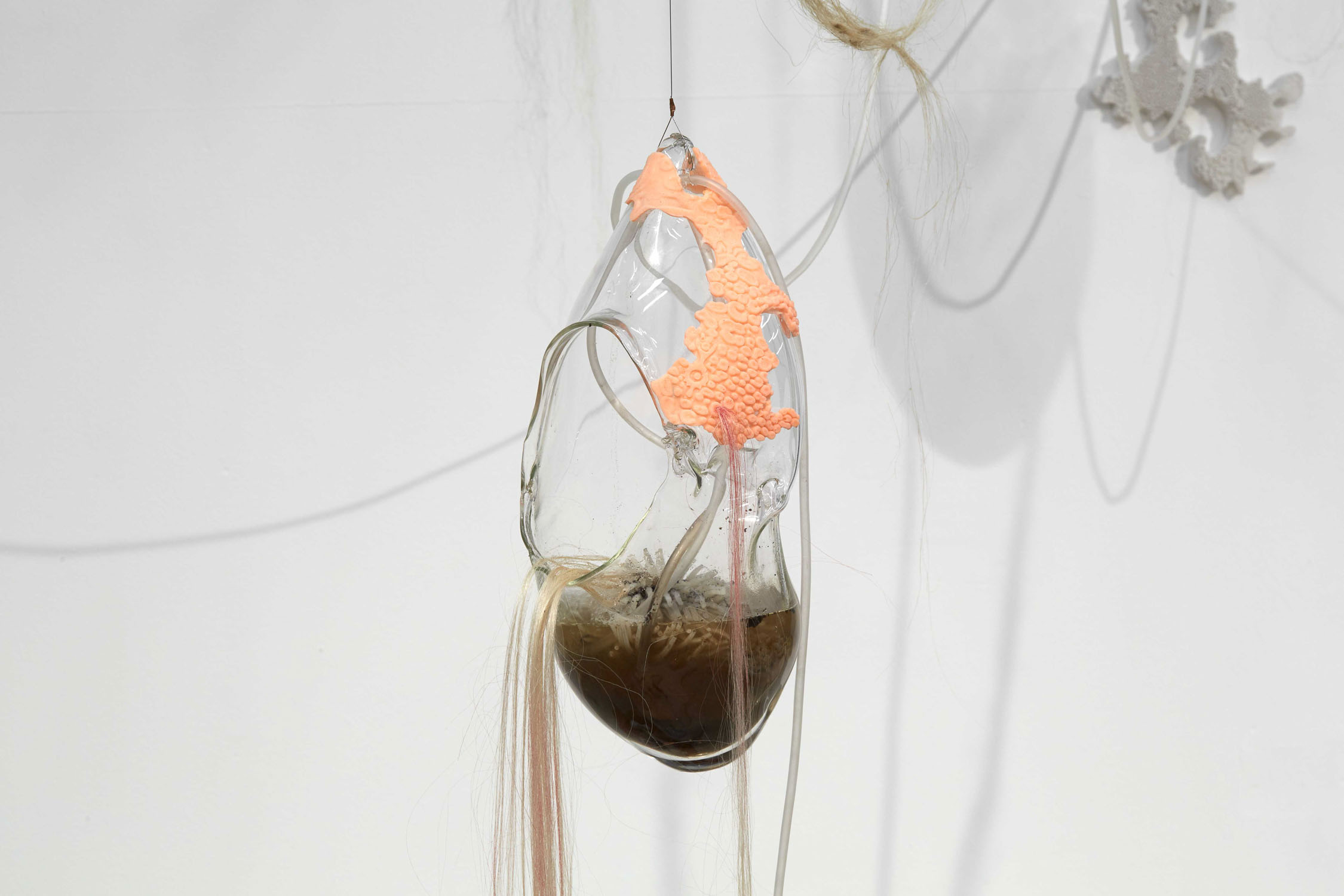
Host
2019
Baum & Leahy in collaboration with Richard Beckett
Exhibited in:
Welcome Home at Elephant West
Hyperobjects at Catalyst Arts
Worlding Worlds at MU Hybrid Art House
Featured on BBC: “Is this what future homes will look like?”
2019
Baum & Leahy in collaboration with Richard Beckett
Exhibited in:
Welcome Home at Elephant West
Hyperobjects at Catalyst Arts
Worlding Worlds at MU Hybrid Art House
Featured on BBC: “Is this what future homes will look like?”
Host is the primordial memory of your future
home.
A gut reaction to the loss of biodiversity within domestic, indoor
ecosystems. This slow, soft, moist and messy antidote to over-sanitised insanity
invites you to feel at home with the presence of your microscopic housemates.
Immerse yourself and your cells in a future of microbiophilic living,
rest and
rewild, heal, host and be hosted by your cohabiting microbes.
Live microbial communities in glass vessels are suspended over and emerging from a landscape of soft, gut-like cushions. The cultures reside on the surfaces around you, flow between the vessels, are distributed via mist and instantly engage in intimate exchange with your microbial body. Porous, bio-receptive tiles, developed with architect Richard Beckett, suggest how in the future our surrounding surfaces could be designed to host different forms of life, moving towards probiotic, regenerative architecture. The physicality and materiality of the space suggests the fractal relationship between microbial, mammalian and domestic matter. Here, you are regenerated cell by cell. Somewhere between a garden, a pharmacy and your bathroom medicine cupboard, this responsive space
heals you, and in return, you grow it.
Live microbial communities in glass vessels are suspended over and emerging from a landscape of soft, gut-like cushions. The cultures reside on the surfaces around you, flow between the vessels, are distributed via mist and instantly engage in intimate exchange with your microbial body. Porous, bio-receptive tiles, developed with architect Richard Beckett, suggest how in the future our surrounding surfaces could be designed to host different forms of life, moving towards probiotic, regenerative architecture. The physicality and materiality of the space suggests the fractal relationship between microbial, mammalian and domestic matter. Here, you are regenerated cell by cell. Somewhere between a garden, a pharmacy and your bathroom medicine cupboard, this responsive space
heals you, and in return, you grow it.

Our meaty, mammalian bodies are host and home
to a ubiquitous shimmer of invisible microorganisms: bacteria, archaea,
protozoa, fungi and more. So incomprehensibly tiny, more than half a million
bacteria could fit inside this comma, yet our microbial communities, known as
the human microbiome, are monumental in shaping our health through a myriad of
genetic functions. Blurring the boundaries between animate and inanimate
matter, these personal microbial ecologies not only exist around and within
everyone, but also reside everywhere inside our built environments. Every home
hosts its own microbiota - the hundreds of thousands species-strong family that
you never knew you were living with.
This ancient microbe-mammal-symbiosis is currently inadvertently undergoing dramatic changes. The Hygiene Hypothesis suggests that a decreased exposure to outdoor microbial diversity in urban indoor environments correlates with a rise in autoimmune and allergic diseases. In the future, our increasingly sanitised domestic spaces could result in a ‘silent microbiome crisis’, in which the loss of diverse microbial communities puts our overall health at risk.
Host responds both to this internal and external over-sterilisation of our bodies and habitats and explores how microbial biodiversity can be re-introduced to foster healthy, regenerative multispecies living spaces. As well as the multitude of microbes already inhabiting this installation and gallery space, Host centres around the diverse microbial communities found in cultures of kombucha and soil. Kombucha, a well-known symbiotic culture of yeast and bacteria, has been domestically fermented as a healing remedy for millenia. In a handful of soil, billions of individual microscopic cells, tens of thousands of different species, reside - many of which also live in your gut. Nostalgic earthy and acidic smells amongst soft surfaces invite physical and sensorial intimacy, as your microbes enrich and contribute to the microbial diversity of the space.
Host envisions a hybrid, rewilded space nurturing the biodiversity within which the mammalian immune system evolved, whilst also suggesting how we might learn to live consciously with the multi-faceted, unpredictable ways of the microbes. Beginning with our own personal and collective healing, in our bodies and homes, we seed the emergence of environmental healing on a planetary scale.
This ancient microbe-mammal-symbiosis is currently inadvertently undergoing dramatic changes. The Hygiene Hypothesis suggests that a decreased exposure to outdoor microbial diversity in urban indoor environments correlates with a rise in autoimmune and allergic diseases. In the future, our increasingly sanitised domestic spaces could result in a ‘silent microbiome crisis’, in which the loss of diverse microbial communities puts our overall health at risk.
Host responds both to this internal and external over-sterilisation of our bodies and habitats and explores how microbial biodiversity can be re-introduced to foster healthy, regenerative multispecies living spaces. As well as the multitude of microbes already inhabiting this installation and gallery space, Host centres around the diverse microbial communities found in cultures of kombucha and soil. Kombucha, a well-known symbiotic culture of yeast and bacteria, has been domestically fermented as a healing remedy for millenia. In a handful of soil, billions of individual microscopic cells, tens of thousands of different species, reside - many of which also live in your gut. Nostalgic earthy and acidic smells amongst soft surfaces invite physical and sensorial intimacy, as your microbes enrich and contribute to the microbial diversity of the space.
Host envisions a hybrid, rewilded space nurturing the biodiversity within which the mammalian immune system evolved, whilst also suggesting how we might learn to live consciously with the multi-faceted, unpredictable ways of the microbes. Beginning with our own personal and collective healing, in our bodies and homes, we seed the emergence of environmental healing on a planetary scale.




Microbes present in the installation:
Kombucha (Microbe Genera include Acetobacter, Candida, Gluconobacter, Lactobacillus, Saccharomyces, Saccharomycodes, Schizosaccharomyces, Zygosaccharomyces, Brettanomyces/Dekkera, Candida, Torulospora, Koleckera, Pichia, Mycotorula, Mycoderma, Torula, Torulopsis, Kluyveromyces)
Garden soil (Microbe Genera include Achromobacter, Acidicapsa, Acidiphilium, Acidisoma, Acidobacterium, Acidocella, Acidovorax, Acinetobacter, Actinoallomurus, Actinocatenispora, Actinomadura, Actinomyces, Actinomycetospora, Actinoplanes, Actinopolymorpha, Actinotalea, Adhaeribacter, Aequorivita, Aeromicrobium, Aetherobacter, Afifella, Afipia, Agrobacterium, Agromyces, Alicyclobacillus, Alkanibacter, Alkanindiges, Amaricoccus, Aminobacter, Ammoniphilus, Amycolatopsis, Anaerolinea, Anaeromyxobacter, Anaerovibrio, Anaerovorax, Ancylobacter, Aneurinibacillus, Anoxybacillus, Aquabacterium, Aquicella, Archangium, Ardenscatena, Arenimonas, Arthrobacter, Asteroleplasma, Asticcacaulis, Asticcacaulis, Azohydromonas, Azospirillum, B-42, Bacillus, Balneimonas, Bdellovibrio, Beijerinckia, Bifidobacterium, Bordetella, Bosea, Brachybacterium, Bradyrhizobium, Brevibacillus, Brevibacterium, Brevundimonas, Bryobacter, Burkholderia, Butyrivibrio, Caldilinea, Caloramator, Camelimonas, Candidatus, Candidimonas, Catellatospora, Caulobacter, Cellulomonas, Cellulosimicrobium, Cellvibrio, Chelativorans, Chelatococcus, Chelatococcus, Chloronema, Chondromyces, Chryseobacterium, Chthoniobacter, Clostridium, Cohnella, Collimonas, Collinsella, Comamonas, Conexibacter, Coprococcus, Corallococcus, Corynebacterium, Couchioplanes, Crenothrix, Crocinitomix, Cryocola, Cryptosporangium, Cupriavidus, Curtobacterium, Cystobacter, Cytophaga, DA101, Dactylosporangium, Dechloromonas, Demequina, Denitrobacter, Dermacoccus, Desulfosporosinus, Desulfotomaculum, Devosia, Dok59, Dokdonella, Dongia, Duganella, Dyadobacter, Dyella, Edaphobacter, Ellin506, Emticicia, Ensifer, Erwinia, Erythromicrobium, Escherichia, Ethanoligenens, FFCH10602, Fimbriimonas, Flavihumibacter, Flavisolibacter, Flavobacterium, Fluviicola, Frankia, Frigoribacterium, Fusibacter, Gemmata, Gemmatimonas, Geobacillus, Geobacter, Geodermatophilus, Geothrix, Gluconacetobacter, Glycomyces, Gordonia, Gracilibacter, Granulicella, Gynumella, Herbaspirillum, Herminiimonas, HeteroC45_4W, Hyphomicrobium, Iamia, Isosphaera, Janthinobacterium, JG37-AG-70, Jiangella, Kaistia, Kaistobacter, Kibdelosporangium, Kineosporia, Kitasatospora, Knoellia, Kouleothrix, Kribbella, Ktedonobacter, Kutzneria, Kyrpidia, Labrys, Larkinella, Leadbetterella, Lechevalieria, Legionella, Lentzea, Leptothrix, Luteibacter, Luteimonas, Luteolibacter, Lysinibacillus, Lysobacter, Magnetospirillum, Marmoricola, Massilia, Mesorhizobium, Mesorhizobium, Methanobacterium, Methanobrevibacter, Methanoculleus, Methanomassiliicoccus, Methanosarcina, Methylibium, Methylobacillus, Methylobacter, Methylobacterium, Methylocaldum, Methylocella, Methylosinus, Methylotenera, Methylovirgula, Micromonospora, Mucilaginibacter, Mycobacterium, Mycoplana, Myxococcus, Nannocystis, Nevskia, Niabella, Nitrosopumilus, Nitrosotalea, Nitrosovibrio, Nitrospira, Nocardia, Nocardioides, Nocardioides, Nonomuraea, Novosphingobium, Ochrobactrum, Olivibacter, Opitutus, OR-59, Oribacterium, Oryzihumus, Oxalobacter, Paenibacillus, Paenibacillus, Panacagrimonas, Pandoraea, Paracoccus, Parapedobacter, Parasegitibacter, Parvibaculum, Patulibacter, Paucibacter, Paucimonas, Pedobacter, Pedomicrobium, Pedosphaera, Pelomonas, Pelosinus, Peredibacter, Perlucidibaca, Phaeospirillum, Phenylobacterium, Phormidium, Phycicoccus, Phyllobacterium, Pigmentiphaga, Pilimelia, Pimelobacter, Pirellula, Planctomyces, planctomycete, Planifilum, Planomicrobium Pleomorphomonas, Plesiocystis, Pontibacter, Prevotella, Promicromonospora, Prosthecobacter, Pseudochrobactrum, Pseudoclavibacter, Pseudomonas, Pseudomonas, Pseudonocardia, Pseudonocardia, Pseudoxanthomonas, Pullulanibacillus, Pusillimonas, Rahnella, Ralstonia, Ramlibacter, Rathayibacter, Reyranella, RFN20, Rhizobium, Rhodanobacter, Rhodobacter, Rhodococcus, Rhodoferax, Rhodomicrobium, Rhodopila, Rhodoplanes, Rhodovulum, Rickettsiella, Roseomonas, Rubrivivax, Rubrobacter, Rudaea, Rugosimonospora, Ruminococcus, Ruminofilibacter, Rummeliibacillus, Saccharomonospora, Saccharopolyspora, Salinibacterium, Salinisphaera, Salinispora, Sanguibacter, Sediminibacterium, Segetibacter, Serratia, SHD-231, Shimazuella, Shinella, Silvimonas, Simkania, Simplicispira, Singulisphaera, Sinomonas, Skermanella, Smaragdicoccus, Solibacillus, Solimonas, Solirubrobacter, Solitalea, Sorangium, Sphaerisporangium, Sphingobacterium, Sphingobium, Sphingomonas, Sphingopyxis, Sporanaerobacter, Sporichthya, Sporocytophaga, Sporolactobacillus, Sporosarcina, Sporotomaculum, Stenotrophomonas, Steroidobacter, Streptacidiphilus, Streptococcus, Streptomyces, Streptosporangium, Sulfuritalea, Symbiobacterium, Syntrophobacter, Telmatospirillum, Tepidibacter, Tepidimicrobium, Terracoccus, Terriglobus, Thermoactinomyces, Thermoanaerobacterium, Thermobifida, Thermobispora, Thermomonas, Thermus, Treponema, Turicibacter, Turneriella, Uliginosibacterium, Ureibacillus, Variovorax, Variovorax, Virgibacillus, Virgisporangium, Williamsia, Woodsholea, Xanthomonas, Xylanimicrobium, YNPFFP6, Yonghaparkia, Zhouia), microbes in Elephant West and of your body.
Kombucha (Microbe Genera include Acetobacter, Candida, Gluconobacter, Lactobacillus, Saccharomyces, Saccharomycodes, Schizosaccharomyces, Zygosaccharomyces, Brettanomyces/Dekkera, Candida, Torulospora, Koleckera, Pichia, Mycotorula, Mycoderma, Torula, Torulopsis, Kluyveromyces)
Garden soil (Microbe Genera include Achromobacter, Acidicapsa, Acidiphilium, Acidisoma, Acidobacterium, Acidocella, Acidovorax, Acinetobacter, Actinoallomurus, Actinocatenispora, Actinomadura, Actinomyces, Actinomycetospora, Actinoplanes, Actinopolymorpha, Actinotalea, Adhaeribacter, Aequorivita, Aeromicrobium, Aetherobacter, Afifella, Afipia, Agrobacterium, Agromyces, Alicyclobacillus, Alkanibacter, Alkanindiges, Amaricoccus, Aminobacter, Ammoniphilus, Amycolatopsis, Anaerolinea, Anaeromyxobacter, Anaerovibrio, Anaerovorax, Ancylobacter, Aneurinibacillus, Anoxybacillus, Aquabacterium, Aquicella, Archangium, Ardenscatena, Arenimonas, Arthrobacter, Asteroleplasma, Asticcacaulis, Asticcacaulis, Azohydromonas, Azospirillum, B-42, Bacillus, Balneimonas, Bdellovibrio, Beijerinckia, Bifidobacterium, Bordetella, Bosea, Brachybacterium, Bradyrhizobium, Brevibacillus, Brevibacterium, Brevundimonas, Bryobacter, Burkholderia, Butyrivibrio, Caldilinea, Caloramator, Camelimonas, Candidatus, Candidimonas, Catellatospora, Caulobacter, Cellulomonas, Cellulosimicrobium, Cellvibrio, Chelativorans, Chelatococcus, Chelatococcus, Chloronema, Chondromyces, Chryseobacterium, Chthoniobacter, Clostridium, Cohnella, Collimonas, Collinsella, Comamonas, Conexibacter, Coprococcus, Corallococcus, Corynebacterium, Couchioplanes, Crenothrix, Crocinitomix, Cryocola, Cryptosporangium, Cupriavidus, Curtobacterium, Cystobacter, Cytophaga, DA101, Dactylosporangium, Dechloromonas, Demequina, Denitrobacter, Dermacoccus, Desulfosporosinus, Desulfotomaculum, Devosia, Dok59, Dokdonella, Dongia, Duganella, Dyadobacter, Dyella, Edaphobacter, Ellin506, Emticicia, Ensifer, Erwinia, Erythromicrobium, Escherichia, Ethanoligenens, FFCH10602, Fimbriimonas, Flavihumibacter, Flavisolibacter, Flavobacterium, Fluviicola, Frankia, Frigoribacterium, Fusibacter, Gemmata, Gemmatimonas, Geobacillus, Geobacter, Geodermatophilus, Geothrix, Gluconacetobacter, Glycomyces, Gordonia, Gracilibacter, Granulicella, Gynumella, Herbaspirillum, Herminiimonas, HeteroC45_4W, Hyphomicrobium, Iamia, Isosphaera, Janthinobacterium, JG37-AG-70, Jiangella, Kaistia, Kaistobacter, Kibdelosporangium, Kineosporia, Kitasatospora, Knoellia, Kouleothrix, Kribbella, Ktedonobacter, Kutzneria, Kyrpidia, Labrys, Larkinella, Leadbetterella, Lechevalieria, Legionella, Lentzea, Leptothrix, Luteibacter, Luteimonas, Luteolibacter, Lysinibacillus, Lysobacter, Magnetospirillum, Marmoricola, Massilia, Mesorhizobium, Mesorhizobium, Methanobacterium, Methanobrevibacter, Methanoculleus, Methanomassiliicoccus, Methanosarcina, Methylibium, Methylobacillus, Methylobacter, Methylobacterium, Methylocaldum, Methylocella, Methylosinus, Methylotenera, Methylovirgula, Micromonospora, Mucilaginibacter, Mycobacterium, Mycoplana, Myxococcus, Nannocystis, Nevskia, Niabella, Nitrosopumilus, Nitrosotalea, Nitrosovibrio, Nitrospira, Nocardia, Nocardioides, Nocardioides, Nonomuraea, Novosphingobium, Ochrobactrum, Olivibacter, Opitutus, OR-59, Oribacterium, Oryzihumus, Oxalobacter, Paenibacillus, Paenibacillus, Panacagrimonas, Pandoraea, Paracoccus, Parapedobacter, Parasegitibacter, Parvibaculum, Patulibacter, Paucibacter, Paucimonas, Pedobacter, Pedomicrobium, Pedosphaera, Pelomonas, Pelosinus, Peredibacter, Perlucidibaca, Phaeospirillum, Phenylobacterium, Phormidium, Phycicoccus, Phyllobacterium, Pigmentiphaga, Pilimelia, Pimelobacter, Pirellula, Planctomyces, planctomycete, Planifilum, Planomicrobium Pleomorphomonas, Plesiocystis, Pontibacter, Prevotella, Promicromonospora, Prosthecobacter, Pseudochrobactrum, Pseudoclavibacter, Pseudomonas, Pseudomonas, Pseudonocardia, Pseudonocardia, Pseudoxanthomonas, Pullulanibacillus, Pusillimonas, Rahnella, Ralstonia, Ramlibacter, Rathayibacter, Reyranella, RFN20, Rhizobium, Rhodanobacter, Rhodobacter, Rhodococcus, Rhodoferax, Rhodomicrobium, Rhodopila, Rhodoplanes, Rhodovulum, Rickettsiella, Roseomonas, Rubrivivax, Rubrobacter, Rudaea, Rugosimonospora, Ruminococcus, Ruminofilibacter, Rummeliibacillus, Saccharomonospora, Saccharopolyspora, Salinibacterium, Salinisphaera, Salinispora, Sanguibacter, Sediminibacterium, Segetibacter, Serratia, SHD-231, Shimazuella, Shinella, Silvimonas, Simkania, Simplicispira, Singulisphaera, Sinomonas, Skermanella, Smaragdicoccus, Solibacillus, Solimonas, Solirubrobacter, Solitalea, Sorangium, Sphaerisporangium, Sphingobacterium, Sphingobium, Sphingomonas, Sphingopyxis, Sporanaerobacter, Sporichthya, Sporocytophaga, Sporolactobacillus, Sporosarcina, Sporotomaculum, Stenotrophomonas, Steroidobacter, Streptacidiphilus, Streptococcus, Streptomyces, Streptosporangium, Sulfuritalea, Symbiobacterium, Syntrophobacter, Telmatospirillum, Tepidibacter, Tepidimicrobium, Terracoccus, Terriglobus, Thermoactinomyces, Thermoanaerobacterium, Thermobifida, Thermobispora, Thermomonas, Thermus, Treponema, Turicibacter, Turneriella, Uliginosibacterium, Ureibacillus, Variovorax, Variovorax, Virgibacillus, Virgisporangium, Williamsia, Woodsholea, Xanthomonas, Xylanimicrobium, YNPFFP6, Yonghaparkia, Zhouia), microbes in Elephant West and of your body.


Credits
Production
Soil-mist tiles and tentacular surface expanding elements made in collaboration with Richard Beckett
Glassworks designed by Baum & Leahy and blown by Adam Aaronson Studio
Mist system produced with support-in-kind from Glen Dimplex
Additional production support
Greg Orrom Swan and Deborah Mora
Consultation
Rob Dunn, Biologist, writer and professor in the Department of Applied Ecology at North Carolina State University.
Birgitte Rubæk, Exhibitions and Interpretations Manager at the Natural History Museum, Copenhagen
Adam Bencard, Lecturer, researcher and curator at Medical Museion, Copenhagen
Peder Worning, Researcher and bioinformatician at Hvidovre Hospital, Copenhagen, author and science communicator
Simone Zuffa, PhD candidate specialising in early-life microbiomics and metabolomics, Imperial College London
Photos by Thomas Adank, Oliver Holms and Hanneke Wetzer
Video by TimeBomb Studios
© Rose Leahy 2020